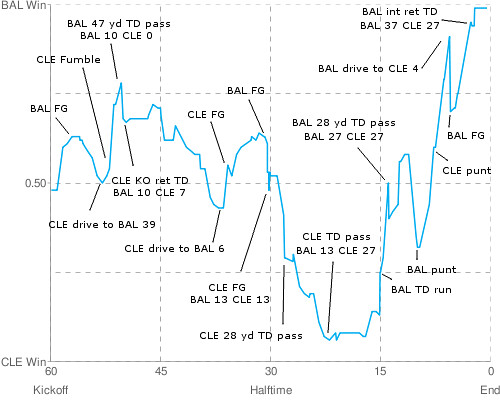 Instead of focusing on a single "play of the week," which is often simply the longest interception return in the week, I thought it might be more interesting to look at the anatomy of an entire game from the perspective of win probability. Each game of the week might feature an improbable comeback, a stunning upset, a game-changing blown call by the refs, or a critically important coaching decision.
Instead of focusing on a single "play of the week," which is often simply the longest interception return in the week, I thought it might be more interesting to look at the anatomy of an entire game from the perspective of win probability. Each game of the week might feature an improbable comeback, a stunning upset, a game-changing blown call by the refs, or a critically important coaching decision.
This week I'm going to look at the Baltimore-Cleveland game which was characterized both by a big comeback and a (small) upset. After taking an early 10-0 lead, Baltimore fell behind in the 3rd quarter. Then trailing by 2 touchdowns early in the 4th quarter, the usually plodding Ravens offense reeled off 17 unanswered points to take the lead 30-27. Baltimore's defense then intercepted Derek Anderson and returned the ball for a game-clinching touchdown, making the final score Baltimore 37 Cleveland 27.
More after the jump.
I want to use this game to illustrate a couple of interesting things about the flow of the game. The first thing I'd like to point out is that a field goal usually represents a drop in WP. Stalled drives nearing the end zone have the potential for more than 3 points. So a 3-point field goal is almost never something to be happy with. Plus the ensuing kickoff gives the opposition possession which reduces the relative value of the field goal in terms of WP. The only times a field goal is truly 'good' is at the end of the 1st half, or at the end of the game to tie, win, or take a > 8-point lead.
This is most apparent toward the end of close games. Notice the narrow spike in the 4th quarter. The Ravens drove to the Cleveland 4 yd-line, but had to settle for a FG. Although it gave them a 30-27 lead, settling for the FG dropped their WP from about 0.90 to about 0.70. You can notice the same effect in the 2nd quarter. Trailing 10-7, the Browns drove to the Baltimore 6 yard line. Settling for a FG took them from a 0.60 WP to a 0.45 WP. Even though they tied the score, the WP did not become 0.50/0.50. The ball now goes to Baltimore, and possession anywhere forward of one's own 15 yard line makes it more likely the offense will be the next team to score.
The second thing I'd like to point out is the very large effect even a single punt, which is also amplified late in a game. After the Ravens' game-tying touchdown to start the 4th quarter, the Browns and Ravens each exchanged 3-and-outs. Notice how the graph spikes upward, indicating about a 0.60 WP for Baltimore after Cleveland's punt, then drops precipitously back to about 0.70 in the Browns' favor after Baltimore returned the favor. Again, the Browns offense was forced to punt (following a Braylon Edwards sure TD drop), giving Baltimore the ball and the edge in WP for the rest of the game. Of course, 50-yd TD passes and 40-yd runs make for exciting football and can change a game. But it's often the unspectacular plays that can subtly tip the balance and ultimately make the difference.
WP graphs from the other week 9 games are here.
- Home
- win probability
- Game of the Week
Game of the Week
By
Brian Burke
published on 11/04/2008
in
win probability
Subscribe to:
Post Comments (Atom)







